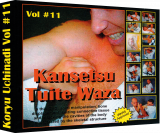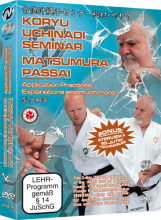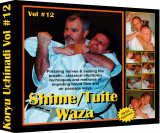Koryu Uchinadi Vol.13 Nage Waza
Download
Artikelnummer: KU-13DL
By Patrick McCarthy – International Ryukyu Karate Research Society
IRKRS Koryu Uchinadi Nage-Waza
Before the advent of modern Karate, there existed a remarkable martial arts in Okinawa referred to as Ryukyu Kempo Toudi-Jutsu.
Simplifed for the purpose being put into Okinawa's turn-of-the-century school system to build robust bodies and militaristic mentalities, in support of Japan's escalating war machine, Ryukyu Kempo Toudi-Jutsu ultimately became influenced by Japanese Budo culture which transformed the revised practice into a sport and cultural recreation.
Koryu Uchinadi Kempo-Jutsu is a unique collection & functional re-interpretation of old-school tegumi grappling drills & those embryonic Fujian-based quanfa practices once secretly cultivated before the development of the modern tradition.
Re-systematized into a cohesive & completely application-based study, it came about as a result of researcher, author and master instructor, Patrick McCarthy, fusing together the principal teachings from many of this tradition's most celebrated pioneers.
Having studied the art since childhood, Patrick McCarthy is one of the few non-Japanese master-level instructors regularly invited to teach kata application, pressure point theory and the history of traditional Karate all over the world.
A former world karate champion, a published re-searcher and a professional teacher, McCarthy Hanshi spend years in Japan researching and developing a simple yet effective way through which to teach the functional application principles of kata.
This is a unique presentation on the principal throwing, take-down and techniques of balance displacement.
For the very first time ever this highly functional two-person practice has been made public.
Developed by myself [Patrick McCarthy] this two-person drill brings together no fewer than fifty-five different ways of displacing an opponent’s balance and should be considered mandatory learning by all.
Nage-Waza provides learners of any rank and or style with an extraordinary repertoire of kata-based application practices. Balance displacement Classical Throws Take-downs.
While nage-waza is not the principal source of self-defense used in the art of karate, it is, nonetheless, an indispensable component of effective fighting, and also reflects a forgotten aspect from this art’s early origins.
Nage-waza is also something that every student of karate, irrespective of style or politics, should gain some level of proficiency in.
As all domestic forms of self-protection can be bridged together by the same habitual acts of physical violence they seek to address, winding up in a clinch is sometimes an inevitable outcome.
While almost everything we do in percussive impact-based traditions is to avoid ever getting into a standing clinch, if and when such a thing was to ever happen, taking immediate control of the situation is of the utmost importance, and it is at this point in time that nage-waza reveals its true value.
We doubt anyone could dispute the sense it makes to be well prepared and never need nage-waza than to wind up in a standing clinch one day with the safety of your life or well-being left only to chance.
Here’s your chance to learn directly from a 5th-generation master of Okinawan Karate.
Language: English
Running Time: 137 Minutes
IRKRS Koryu Uchinadi Nage-Waza
Before the advent of modern Karate, there existed a remarkable martial arts in Okinawa referred to as Ryukyu Kempo Toudi-Jutsu.
Simplifed for the purpose being put into Okinawa's turn-of-the-century school system to build robust bodies and militaristic mentalities, in support of Japan's escalating war machine, Ryukyu Kempo Toudi-Jutsu ultimately became influenced by Japanese Budo culture which transformed the revised practice into a sport and cultural recreation.
Koryu Uchinadi Kempo-Jutsu is a unique collection & functional re-interpretation of old-school tegumi grappling drills & those embryonic Fujian-based quanfa practices once secretly cultivated before the development of the modern tradition.
Re-systematized into a cohesive & completely application-based study, it came about as a result of researcher, author and master instructor, Patrick McCarthy, fusing together the principal teachings from many of this tradition's most celebrated pioneers.
Having studied the art since childhood, Patrick McCarthy is one of the few non-Japanese master-level instructors regularly invited to teach kata application, pressure point theory and the history of traditional Karate all over the world.
A former world karate champion, a published re-searcher and a professional teacher, McCarthy Hanshi spend years in Japan researching and developing a simple yet effective way through which to teach the functional application principles of kata.
This is a unique presentation on the principal throwing, take-down and techniques of balance displacement.
For the very first time ever this highly functional two-person practice has been made public.
Developed by myself [Patrick McCarthy] this two-person drill brings together no fewer than fifty-five different ways of displacing an opponent’s balance and should be considered mandatory learning by all.
Nage-Waza provides learners of any rank and or style with an extraordinary repertoire of kata-based application practices. Balance displacement Classical Throws Take-downs.
While nage-waza is not the principal source of self-defense used in the art of karate, it is, nonetheless, an indispensable component of effective fighting, and also reflects a forgotten aspect from this art’s early origins.
Nage-waza is also something that every student of karate, irrespective of style or politics, should gain some level of proficiency in.
As all domestic forms of self-protection can be bridged together by the same habitual acts of physical violence they seek to address, winding up in a clinch is sometimes an inevitable outcome.
While almost everything we do in percussive impact-based traditions is to avoid ever getting into a standing clinch, if and when such a thing was to ever happen, taking immediate control of the situation is of the utmost importance, and it is at this point in time that nage-waza reveals its true value.
We doubt anyone could dispute the sense it makes to be well prepared and never need nage-waza than to wind up in a standing clinch one day with the safety of your life or well-being left only to chance.
Here’s your chance to learn directly from a 5th-generation master of Okinawan Karate.
Language: English
Running Time: 137 Minutes
Kundenrezensionen
Es gibt noch keine Rezensionen für dieses Produkt.





